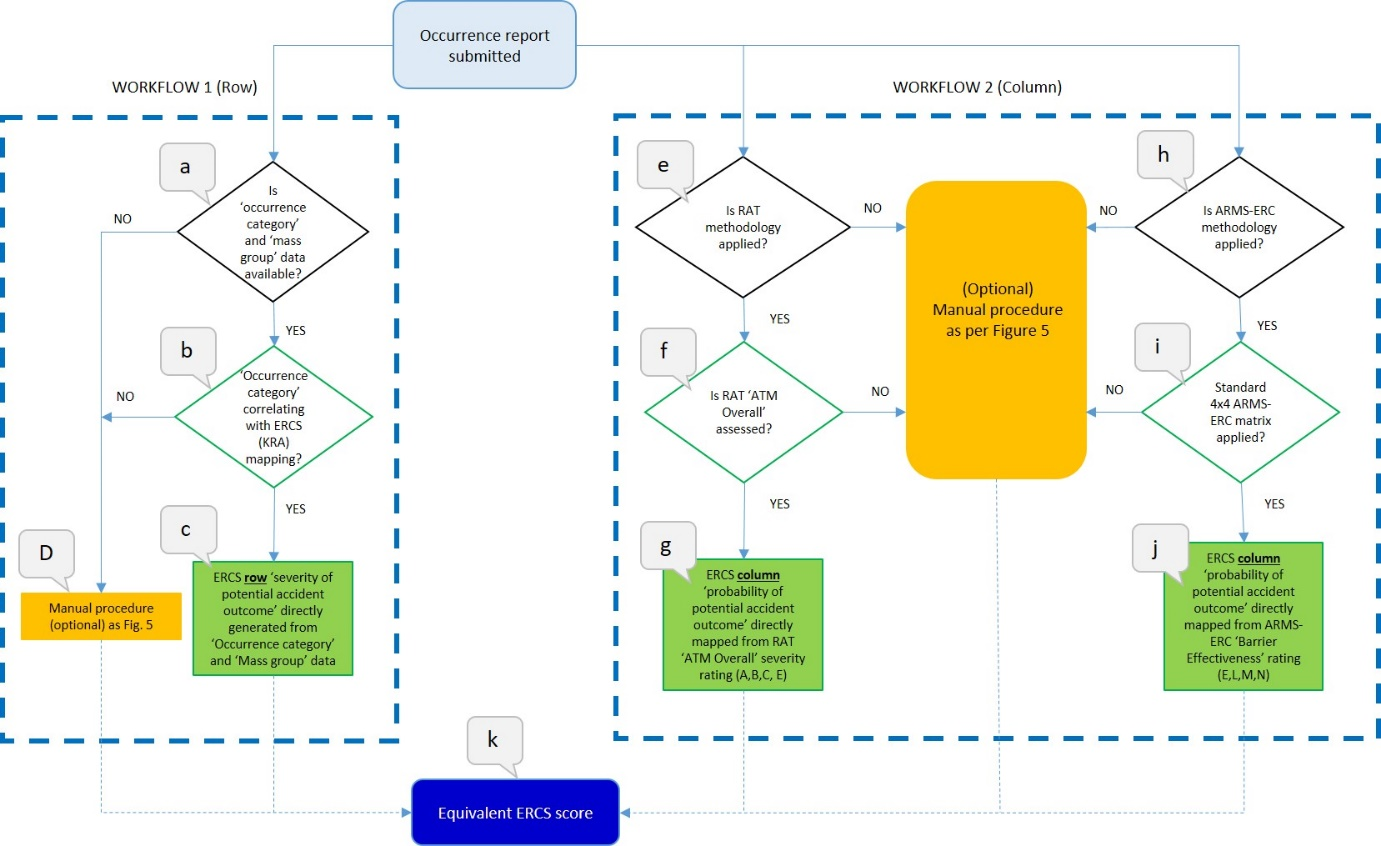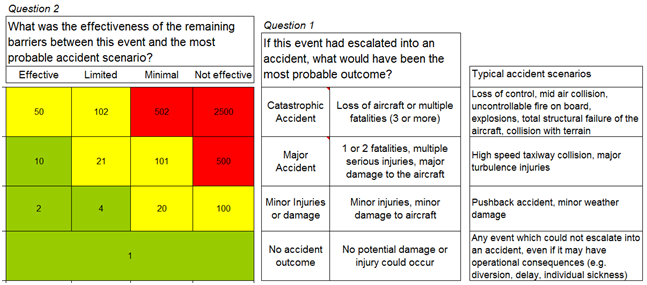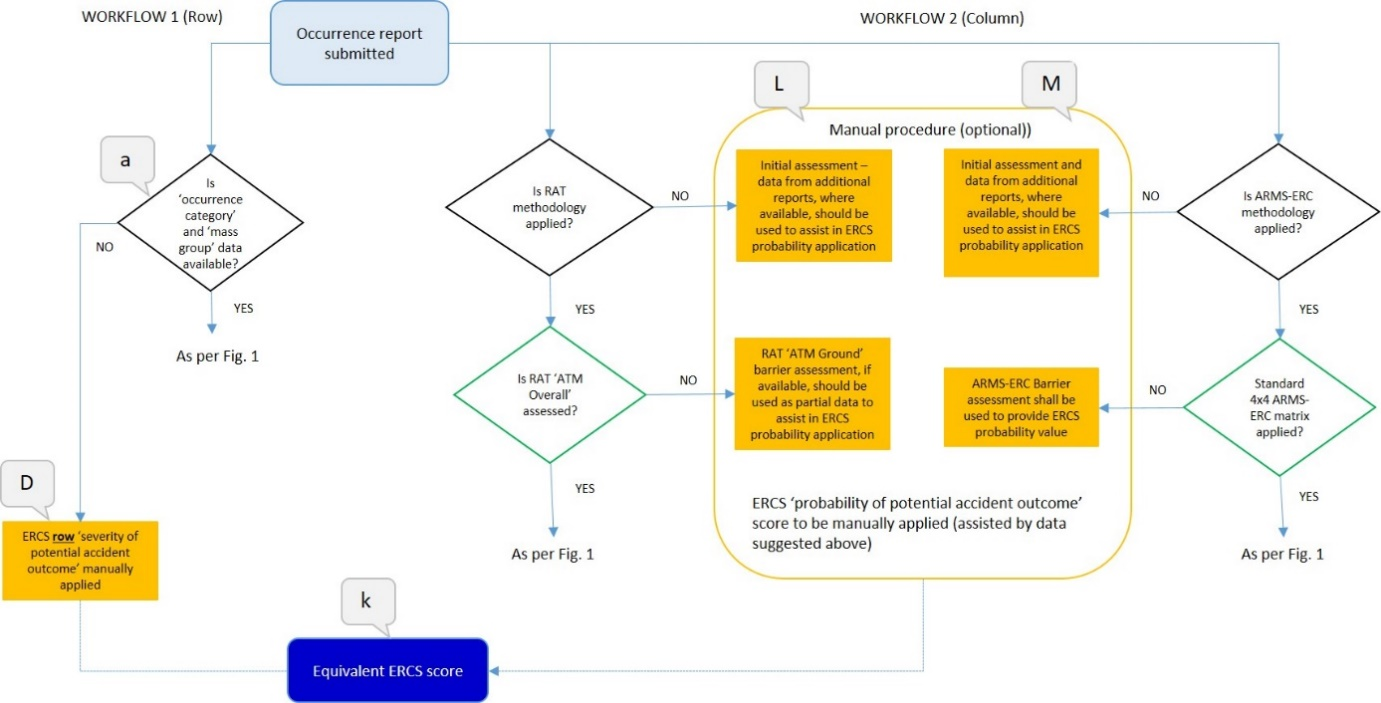Conversion procedures from the Risk Analysis Tool (RAT) and Aviation Risk Management Solutions — Event Risk Classification (ARMS-ERC) scores into the European Risk Classification Scheme (ERCS) scores
Regulation (EU) 2021/2082
This Annex lays down conversion procedures from RAT and ARMS ERC scores to the ERCS score (44 The ERCS score is a two-digit value where the first digit corresponds to the alphabetic value resulting from the calculation of the severity of the occurrence (severity score A to X) and the second digit represents the numerical value from the calculation of the corresponding score of the occurrence (probability).) defined in Step 2 of the Annex to Commission Delegated Regulation (EU) 2020/2034.
The following conversion procedures provide either a direct or a manual conversion to obtain an ERCS classification equivalent to the RAT and/or ARMS – ERC scores in accordance with Article 3 of this Regulation.
1. DIRECT CONVERSION
The mandatory conversion procedure consists of the following two workflows:
— Workflow 1 - provides a direct conversion to obtain the ERCS severity score,
— Workflow 2 - provides direct conversion to obtain the ERCS probability score.
Figure 1 shows an overview of the procedures. The starting point of the process is the ‘occurrence report submitted’ box and the output the ‘Equivalent ERCS score’ box. The dotted lines in Figure 1 indicate that only one source for each process result is required.
Figure 1 Conversion procedures

1.1. WORKFLOW 1 – ERCS severity score
a. ‘Occurrence category’ and ‘Mass group’ information
— If the occurrence report contains information on the ‘occurrence category’ of the occurrence and the ‘mass group’, then these can be converted into the ‘Severity of potential accident outcome’ ERCS score. The next step is (b) of Figure 1.
— If the occurrence report contains no information about the ‘occurrence category’ or the ‘mass group’, or both, direct conversion is not possible. If the manual conversion described in point 2 of this Annex is used, then next step is (D) of Figures 1 and 5.
b. ‘Occurrence category’ and ERCS Key Risk Area (KRA) conversion
— If the ‘occurrence category’ of the occurrence report corresponds directly to the one of the ERCS Key Risk Areas defined in point 1.2 of Annex to Delegated Regulation (EU) 2020/2034 then the next step is (c) of Figure 1.
— For occurrence reports with ‘occurrence categories’ different from the ERCS Key Risk Areas, there is no direct conversion. If the manual conversion described in point 2 of this Annex is used, then the next step is (D) of Figures 1 and 5.
c. ERCS ‘Severity of potential accident outcome’ score – direct conversion
— If the occurrence report contains information about ‘occurrence category’ and ‘mass group’ then the severity score is directly converted into an appropriate ERCS ‘severity of potential accident outcome’ score. The result is (k), which gives the first digit corresponding to the alphabetic value resulting from the calculation of the severity of the occurrence (severity score A to X).
1.2. WORKFLOW 2 – ERCS probability score
e. Occurrence report scored using RAT
If the occurrence report has been scored using the RAT methodology (45 The RAT methodology classifies Air Traffic Management related occurrences. RAT methodology does not score accidents, as it measures only how close the ATM occurrence was to becoming an accident. The RAT methodology is divided into several main elements (i.e. ‘ATM ground’, ‘ATM airborne’), in which each delivers a part of the input for the final RAT ‘ATM overall’ severity score. In order to achieve ‘ATM Overall’ severity score, both ‘ATM ground’ and ‘ATM airborne’ severity scores must be available.):
— Occurrence reports that have a RAT ‘ATM overall’ severity score classification can be mapped directly to the ERCS probability columns as explained in step (g) of Figure 2,
— Occurrence reports that only have a RAT ‘ATM ground’ severity (46 The ‘severity’ under the RAT methodology indicates how bad the actual occurrence was in comparison to other occurrences. The RAT methodology determines ‘severity’ through an assessment of the defences/barriers.) score have to be manually converted to provide the ERCS probability score. If the manual conversion described in point 2 of this Annex is used, then next step is (L) of figure 5,
— In the case of occurrence reports coded as ‘ATM-specific occurrence’, conversion between the RAT and ERCS scores is not possible.
f. RAT ‘ATM overall’ severity score
— If an occurrence report contains the ‘ATM overall’ severity score, then the next step is (g) of Figure 1.
g. ERCS column ‘Probability of potential accident outcome’ converted from RAT ‘ATM Overall’ value ( relevant only for A, B, C, E values)
For the occurrence reports with an ‘ATM Overall’ severity score (A, B, C, E) classification, the following direct conversion into ERCS probability categories applies:
Figure 2 RAT ATM overall severity score conversion onto the ERCS probability score

h. Occurrence reports classified using the ARMS-ERC methodology
— For the occurrence reports that have been scored according to the ARMS‑ERC, the next step is (i) of Figure 1.
— For the occurrence reports that have not been scored according to the ARMS-ERC methodology, the next step is (M) of Figure 5.
i. Standard 4x4 ARMS-ERC matrix
If the 4x4 ARMS-ERC matrix depicted in Figure 3 is used to score the occurrence report, then the next step is (j) of Figure 1.
Figure 3 Standard 4x4 ARMS-ERC matrix

j. ERCS ‘Probability of the potential accident outcome’ score – direct conversion
If the occurrence report contains an ARMS ‘Barrier Effectiveness’ rating, then to determine the ERCS ‘Probability of potential accident outcome’ score a following direct conversion to the ERCS matrix is used.
Figure 4 Conversion of ARMS-ERC to ERCS probability categories.

k. Equivalent ERCS Score
The combination of the ERCS ‘Severity of potential accident outcome’ and ‘Probability of potential accident outcome’ scores are combined in the ERCS matrix to generate an equivalent ERCS score as laid down in Step 2 of Annex to Delegated Regulation (EU) 2020/2034.
2. MANUAL CONVERSION
This manual conversion consists of the following two workflows:
— Workflow 1 - provides a manual conversion to obtain the ERCS severity score,
— Workflow 2 - provides a manual conversion to obtain the ERCS probability score.
Figure 5 Manual conversion

2.1. WORKFLOW 1
D. ERCS ‘Severity of potential accident outcome’ score – manual conversion
— If the occurrence report contains no information about the ‘occurrence category’ or ‘mass group’, or both, then the ERCS methodology defined in Annex to Delegated Regulation (EU) 2020/2034 applies to determine the ‘Potential Accident Outcome’ or Key Risk Area. The final result is (k), which gives the first digit corresponding to the alphabetic value resulting from the calculation of the severity of the occurrence (severity score A to X).
2.2. WORKFLOW 2
L. ERCS column ‘Probability of potential accident outcome’ – manual procedure
— For the occurrence reports containing no ‘ATM overall’ severity there is no direct conversion to the ERCS ‘Probability of potential accident outcome’ score.
The ‘ATM ground’ severity can however provide for a partial conversion by mapping the ‘ATM ground’ barrier assessment and the ERCS barrier assessment process defined in point 2.1.3 of Annex to Delegated Regulation (EU) 2020/2034.
M. ERCS ‘Probability of potential accident outcome’ score – manual process
If the occurrence reports do not use the 4x4 ARMS-ERC matrix to score the occurrence, to generate an ERCS ‘Probability of potential accident outcome’ score the ARMS-ERC barrier assessment value is converted into the ERCS barrier assessment laid down in point 2.1.3 of Annex to Delegated Regulation (EU) 2020/2034.
k. Equivalent ERCS Score
The combination of the ERCS ‘Severity of potential accident outcome’ and ‘Probability of potential accident outcome’ scores are combined in the ERCS matrix to generate an equivalent ERCS score as laid down in Step 2 of Annex to Delegated Regulation (EU) 2020/2034.
